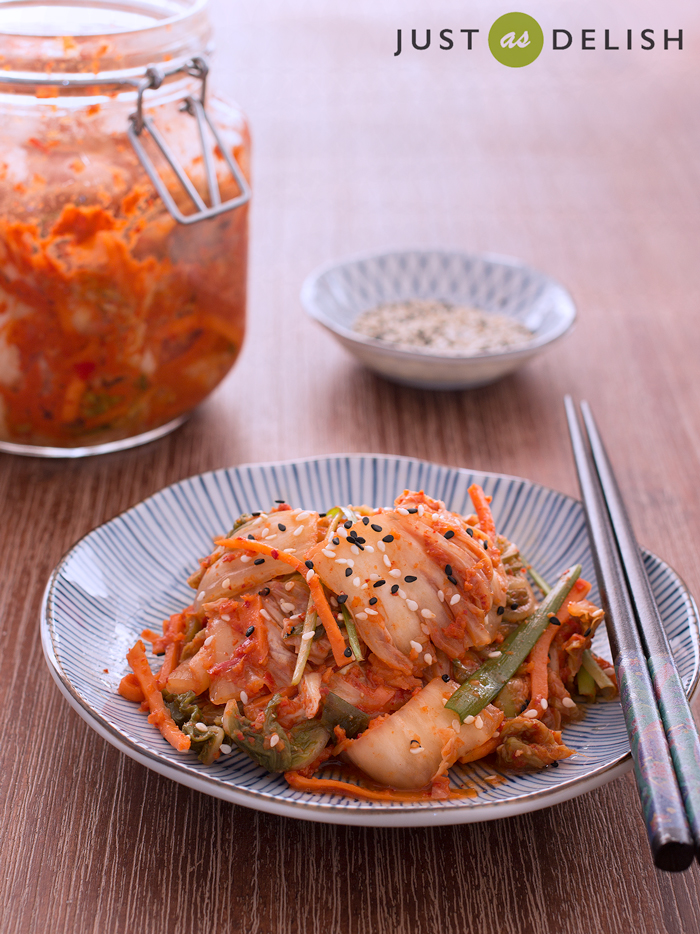Mak Kimchi (Quick Cabbage Kimchi) – the spicy addictive Korean dish that you must absolutely try, with a dose of natural probiotics
After my 1st attempt at making kimchi with bok choy, I kinda become hooked. Actually Norbert loves it more than I do. We’ll eat it with everything from fried rice, noodle soups to pancakes, onigizaru, and, of course, straight out of the jar. This traditional Korean dish creates the healthy bacteria, Lactobacillus (the source of probiotics), during the fermentation process. When we eat fermented foods, it is almost like taking probiotic supplements, except it is delicious and far less expensive.

Some of my cooking with kimchi , photos taken with phone and posted on instagram
Mak kimchi, or quick kimchi is made with napa cabbage cut into bite size pieces before seasoning. This way of making kimchi is much easier and saves time compared to making whole cabbage kimchi. But the taste is exactly the same as whole cabbage kimchi because the ingredients are the same.The vegetarian and vegan version is one of the recipes in my upcoming recipe book Asian Raw Food Kitchen (out in 2 months time!). Most people are quite intimidated by the thought of making kimchi, so I created a simple video of the process to show it is otherwise. Easy peasy, isnt it? 😀 Hope you enjoyed the video and I’m excited to make more videos in future.
Fresh kimchi can be enjoyed on the same day you made but it is best to let it ferment at room temperature of around 20C (68F) for 2 days to create the healthy probiotics bacteria. The time of fermentation depends on the room temperature inside your house. Check the jar after the 1st day. If you see bubbles in the brine, the fermentation should be completed. As shown in the video above, use a spoon to press down the veggies, and there should be bubbles coming from the brine. It should smell and taste sour. Then the fermentation is complete. When the kimchi tastes ‘ripe’ enough for your liking, transfer the jar to the refrigerator. You may eat it right away, but it’s best after another week.

Some of the many scrumptious traditional and fusion creation with kimchi:
º Kimchi Fried Rice – beyondkimchee.com
º Kimchi Jiggae (Kimchi Stew) – seonkyounglongest.com
º Kimchi-jeon (Kimchi Pancake) – maangchi.com
º Kimchi Risotto – norecipe.com
º Kimchi Nachos – kelliesfoodtoglow.com
º Bulgogi Kimchi Taco – chowdivine.com
º Kimchi Pork Belly Pizza – norecipe.com
º Cheese Stuffed Kimchi Pancake – mjandhungryman.com
What’s your favourite way of enjoying kimchi?
- 1 head (1 kg) medium sized Napa Cabbage (Chinese Cabbage)
- 3 cups (750ml) Filtered Water
- 1 cup [url href=”http://amzn.to/2Fw0p7f”]Coarse Sea Salt[/url]
- 4 stalks Spring Onion – cut into strips
- 1 medium Carrot – cut into thin strips
- Kimchi paste
- ½ large White Onion – halved
- 3 cloves Garlic
- 2cm Ginger – diced
- ½ Apple – diced
- ½ Red Capsicum (Red Pepper)
- ¼ cup [url href=”http://amzn.to/2EEChhL”]Korean Chili Flakes (Gochugaru)[/url]
- 1 tbsp [url href=”http://amzn.to/2FzypzV”]Fish Sauce[/url]
- Cut cabbage into quarters, remove the core and cut into 6cm pieces. [br][img src=”http://www.justasdelish.com/wp-content/uploads/2016/06/MakKimchi1-1.jpg” width=”300″ height=”169″ class=”alignnone size-full” title=”MakKimchi1-2-1″]
- Place cabbage in a large non-reactive bowl, and sprinkle with salt. Toss using your hands and add water to cover the cabbage. Put a plate on top and weigh it down with something heavy, like a jar. After 1 hour, use your hand to turn the cabbage and let it soak another hour until the cabbages are well wilted. [br] [img src=”http://www.justasdelish.com/wp-content/uploads/2016/06/MakKimchi12-1.jpg” width=”300″ height=”200″ class=”alignnone size-full” title=”MakKimchi12-1″] [img src=”http://www.justasdelish.com/wp-content/uploads/2016/06/MakKimchi12-2-1.jpg” width=”300″ height=”200″ class=”alignnone size-full” title=”MakKimchi12-2-1″]
- Once the cabbage are wilted (after 2 hours), rinse the cabbage under cold water 3 times, drain in a colander and lightly squeeze out the water from the cabbage.
- Place the paste ingredients in a food processor and puree until completely smooth. [br] [img src=”http://www.justasdelish.com/wp-content/uploads/2016/06/MakKimchi1-5.jpg” width=”300″ height=”200″ class=”alignnone size-full” title=”MakKimchi1-5″] [img src=”http://www.justasdelish.com/wp-content/uploads/2016/06/MakKimchi1-3.jpg” width=”300″ height=”200″ class=”alignnone size-full” title=”MakKimchi1-3″]
- Place rinsed cabbage, carrots, spring onion, and the paste into a big bowl. Wear gloves and toss the mixture well using your hands. Taste your kimchi and adjust seasoning by adding more salt. It should taste a little saltier that you would hope for. [br] [img src=”http://www.justasdelish.com/wp-content/uploads/2016/06/MakKimchi1-4.jpg” width=”300″ height=”200″ class=”alignnone size-full” title=”MakKimchi1-4″] [img src=”http://www.justasdelish.com/wp-content/uploads/2016/06/MakKimchi1-6.jpg” width=”300″ height=”200″ class=”alignnone size-full” title=”MakKimchi1-6″]
- Transfer your kimchi into the glass jar. Try to pack it tightly by pressing down as you are transferring it to the container. Leave about 5 cm space at the top of the jar. If you do not leave some room, kimchi liquid will bubble over and make a mess as it ferments. [br][img src=”http://www.justasdelish.com/wp-content/uploads/2016/06/MakKimchi1-7.jpg” width=”300″ height=”200″ class=”alignnone size-full” title=”MakKimchi1-7″]
- Place jar in cool place, let it ferment at room temperature of 20C for 2 days, depending on the room temperature and preference. When you see bubbles inside the jar, the fermentation is complete. Use a wooden spoon to press down the veggies, and there should be bubbles coming from the brine. Then the fermentation is complete. It should smell and taste sour. Taste a little at this point. When the kimchi tastes ripe enough for your liking, transfer the jar to the refrigerator. You may eat it right away, but it’s best after another week. Consume within the next 1-2 month.
- Serve chilled by itself as side dish or use them in dishes.

2 Comments
Leave a reply →